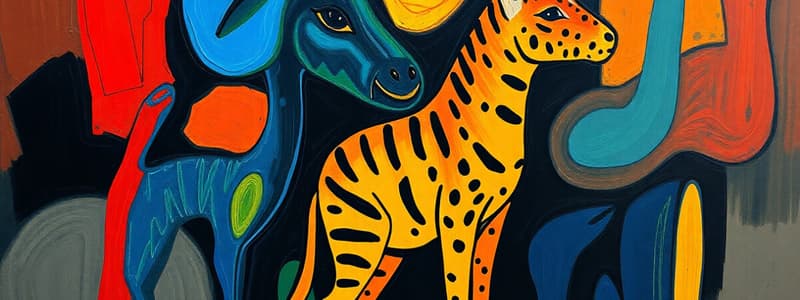Podcast
Questions and Answers
What is primarily responsible for the development and refinement of instinctive behavior patterns in a species?
What is primarily responsible for the development and refinement of instinctive behavior patterns in a species?
- Natural selection (correct)
- Cultural practices of the species
- Environmental changes
- Individual learning processes
Which statement best describes the role of instincts in animals?
Which statement best describes the role of instincts in animals?
- Instincts develop slowly through trial and error.
- Instincts are inherited responses that allow for complex behaviors without prior experience. (correct)
- Instincts are only applicable to mating behaviors.
- Instincts are learned behaviors from observing peers.
What complex behavior do honeybees perform to communicate food sources to their hive?
What complex behavior do honeybees perform to communicate food sources to their hive?
- Patterned movements (correct)
- Dramatic dances
- Vocalization
- Bodily signals
Which of the following is NOT an example of instinctive behavior?
Which of the following is NOT an example of instinctive behavior?
How do bees manage to return to the hive with accuracy after searching for food?
How do bees manage to return to the hive with accuracy after searching for food?
What role does selective breeding play in animal behavior?
What role does selective breeding play in animal behavior?
Which statement about courtship behaviors is true?
Which statement about courtship behaviors is true?
What did early ethologists assume about fixed action patterns?
What did early ethologists assume about fixed action patterns?
What aspect of animal behavior development is emphasized by contemporary ethologists?
What aspect of animal behavior development is emphasized by contemporary ethologists?
Which of the following behaviors is considered a fixed action pattern in birds?
Which of the following behaviors is considered a fixed action pattern in birds?
What does sociobiology suggest about complex social patterns in animals?
What does sociobiology suggest about complex social patterns in animals?
Which of the following is NOT a characteristic of behaviors influenced by genetics?
Which of the following is NOT a characteristic of behaviors influenced by genetics?
How do younger members of a species typically acquire crucial survival behaviors?
How do younger members of a species typically acquire crucial survival behaviors?
Which principle is foundational to the study of sociobiology?
Which principle is foundational to the study of sociobiology?
In the context of sociobiology, what is the significance of survival value?
In the context of sociobiology, what is the significance of survival value?
What does imprinting primarily enable young animals to do?
What does imprinting primarily enable young animals to do?
Which of the following best describes Konrad Lorenz's contribution to ethology?
Which of the following best describes Konrad Lorenz's contribution to ethology?
Which of Tinbergen's questions pertains to the reason a behavior serves for survival and reproduction?
Which of Tinbergen's questions pertains to the reason a behavior serves for survival and reproduction?
What is necessary for ethologists to understand animal behavior according to the content provided?
What is necessary for ethologists to understand animal behavior according to the content provided?
How did Lorenz's work lead to the understanding of fixed action patterns in young animals?
How did Lorenz's work lead to the understanding of fixed action patterns in young animals?
What is the primary type of learning demonstrated by Pavlov's experiments with dogs?
What is the primary type of learning demonstrated by Pavlov's experiments with dogs?
According to behaviorism, how are emotions and thoughts primarily viewed?
According to behaviorism, how are emotions and thoughts primarily viewed?
What key conclusion did Pavlov draw from his work with dogs?
What key conclusion did Pavlov draw from his work with dogs?
Which statement best describes the behaviorist perspective on animals?
Which statement best describes the behaviorist perspective on animals?
What does the stimulus-response theory emphasize in understanding behavior?
What does the stimulus-response theory emphasize in understanding behavior?
What principle did B.F. Skinner demonstrate through his experiments with rats and pigeons?
What principle did B.F. Skinner demonstrate through his experiments with rats and pigeons?
What is instrumental learning in the context of operant conditioning?
What is instrumental learning in the context of operant conditioning?
Which factor is NOT considered crucial in shaping learned behaviors according to behaviorists?
Which factor is NOT considered crucial in shaping learned behaviors according to behaviorists?
How do behaviorists believe complex behaviors are formed?
How do behaviorists believe complex behaviors are formed?
What role does trial-and-error play in Skinner's experiments with rats?
What role does trial-and-error play in Skinner's experiments with rats?
What is a primary characteristic that distinguishes operant conditioning from classical conditioning?
What is a primary characteristic that distinguishes operant conditioning from classical conditioning?
What does contingency refer to in the context of classical conditioning?
What does contingency refer to in the context of classical conditioning?
Which scenario best illustrates the principle of contiguity in classical conditioning?
Which scenario best illustrates the principle of contiguity in classical conditioning?
Which of the following statements about classical conditioning is accurate?
Which of the following statements about classical conditioning is accurate?
Which of the following concepts is most related to learning through consequences?
Which of the following concepts is most related to learning through consequences?
What does the 'Dead Man's Rule' imply in the study of animal behavior?
What does the 'Dead Man's Rule' imply in the study of animal behavior?
Which concept did Darwin introduce that is essential for understanding the natural development of species?
Which concept did Darwin introduce that is essential for understanding the natural development of species?
In Darwin's view, how is animal behavior primarily shaped?
In Darwin's view, how is animal behavior primarily shaped?
What is a key aspect of the classical ethology perspective as proposed by Darwin?
What is a key aspect of the classical ethology perspective as proposed by Darwin?
Why is the study of animal behavior important to professions like veterinary medicine?
Why is the study of animal behavior important to professions like veterinary medicine?
What is the purpose of positive punishment in operant conditioning?
What is the purpose of positive punishment in operant conditioning?
Which of the following is an example of negative reinforcement?
Which of the following is an example of negative reinforcement?
What type of reinforcer would a treat used to train a dog be classified as?
What type of reinforcer would a treat used to train a dog be classified as?
What is the primary focus when employing techniques in animal training?
What is the primary focus when employing techniques in animal training?
Which statement regarding positive reinforcement is accurate?
Which statement regarding positive reinforcement is accurate?
What could potentially be a drawback of employing positive punishment?
What could potentially be a drawback of employing positive punishment?
How would a dog owner effectively utilize reinforcement when training their pet?
How would a dog owner effectively utilize reinforcement when training their pet?
Which scenario best illustrates negative punishment?
Which scenario best illustrates negative punishment?
Flashcards
Ethology
Ethology
A multidisciplinary approach to understanding animal behavior.
Fixed Action Patterns
Fixed Action Patterns
Innate behaviors triggered by specific stimuli, like following parents.
Imprinting
Imprinting
A rapid learning process where young animals bond with caregivers.
Tinbergen's Four Questions
Tinbergen's Four Questions
Signup and view all the flashcards
Konrad Lorenz
Konrad Lorenz
Signup and view all the flashcards
Classical Conditioning
Classical Conditioning
Signup and view all the flashcards
Operant Conditioning
Operant Conditioning
Signup and view all the flashcards
Contiguity
Contiguity
Signup and view all the flashcards
Contingency
Contingency
Signup and view all the flashcards
Neutral Stimulus
Neutral Stimulus
Signup and view all the flashcards
Sociobiology definition
Sociobiology definition
Signup and view all the flashcards
Animal behavior development
Animal behavior development
Signup and view all the flashcards
Natural Selection (in Sociobiology)
Natural Selection (in Sociobiology)
Signup and view all the flashcards
Social patterns
Social patterns
Signup and view all the flashcards
Instinct Definition
Instinct Definition
Signup and view all the flashcards
Instinctive Behavior Examples
Instinctive Behavior Examples
Signup and view all the flashcards
Instinct and Natural Selection
Instinct and Natural Selection
Signup and view all the flashcards
Honeybee Navigation
Honeybee Navigation
Signup and view all the flashcards
Bee Communication
Bee Communication
Signup and view all the flashcards
Selective Breeding
Selective Breeding
Signup and view all the flashcards
Species-Specific Behaviors
Species-Specific Behaviors
Signup and view all the flashcards
Inherited Behavioral Differences
Inherited Behavioral Differences
Signup and view all the flashcards
Fixed Action Patterns (FAPs)
Fixed Action Patterns (FAPs)
Signup and view all the flashcards
Regurgitation Feeding
Regurgitation Feeding
Signup and view all the flashcards
Dead Man's Rule
Dead Man's Rule
Signup and view all the flashcards
Charles Darwin's Contribution
Charles Darwin's Contribution
Signup and view all the flashcards
Natural Selection in Behavior
Natural Selection in Behavior
Signup and view all the flashcards
Innate Behaviors
Innate Behaviors
Signup and view all the flashcards
Evolutionary Perspective on Behavior
Evolutionary Perspective on Behavior
Signup and view all the flashcards
Pavlov's Dogs
Pavlov's Dogs
Signup and view all the flashcards
Conditioned Stimulus
Conditioned Stimulus
Signup and view all the flashcards
Conditioned Response
Conditioned Response
Signup and view all the flashcards
Behaviorism
Behaviorism
Signup and view all the flashcards
Stimulus-Response Theory
Stimulus-Response Theory
Signup and view all the flashcards
Instrumental Learning
Instrumental Learning
Signup and view all the flashcards
Reinforcement
Reinforcement
Signup and view all the flashcards
Punishment
Punishment
Signup and view all the flashcards
Positive Reinforcement
Positive Reinforcement
Signup and view all the flashcards
Negative Reinforcement
Negative Reinforcement
Signup and view all the flashcards
Positive Punishment
Positive Punishment
Signup and view all the flashcards
Negative Punishment
Negative Punishment
Signup and view all the flashcards
Primary Reinforcer
Primary Reinforcer
Signup and view all the flashcards
Secondary Reinforcer
Secondary Reinforcer
Signup and view all the flashcards
Animal Training
Animal Training
Signup and view all the flashcards
Avoid Positive Punishment
Avoid Positive Punishment
Signup and view all the flashcards
Study Notes
Konrad Lorenz
- Konrad Lorenz (1903-1989), a founding father of modern ethology.
- Dedicated his research to identifying various kinds of fixed action patterns.
- Discovered young animals follow parents (including humans) due to auditory or visual cues.
- Imprinting is a process by which young animals bond with caretakers.
- This rapid learning process enables the very young to recognize and bond with caretakers.
Tinbergen's Four Questions
- Function: How does the behavior impact the animal's chance for survival and reproduction?
- Mechanism: What stimuli cause the response? How did learning affect this response?
- Development: Does behavior change with age? Do animals need certain things early in life to be able to do the behavior?
- Evolutionary History: How does behavior correlate to similar behaviors in closely related species? Could this behavior have developed through evolution?
Sociobiology
- Ethologists now realize animal behavior is shaped by learning and environmental influences.
- Younger members of a species may adopt behaviors with little experience
- Sociobiology is the study of the biological basis of social behavior.
- It extends the concept of natural selection to social behavior in animals.
- Behaviors may develop, and sometimes disappear; based on survival.
Studying That Suits You
Use AI to generate personalized quizzes and flashcards to suit your learning preferences.




